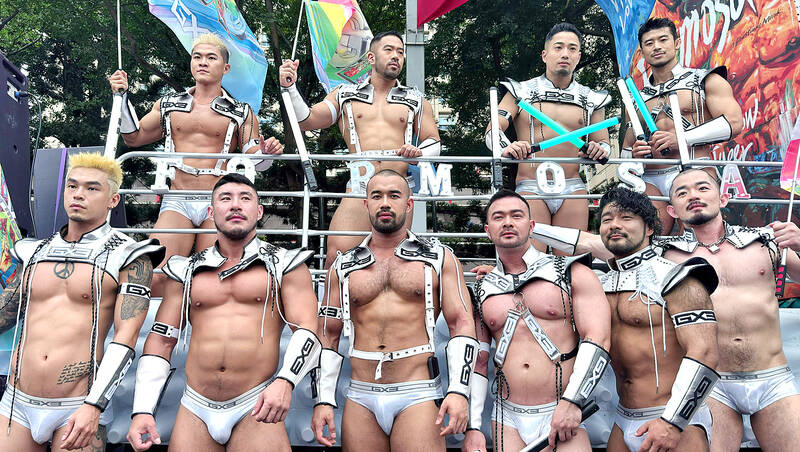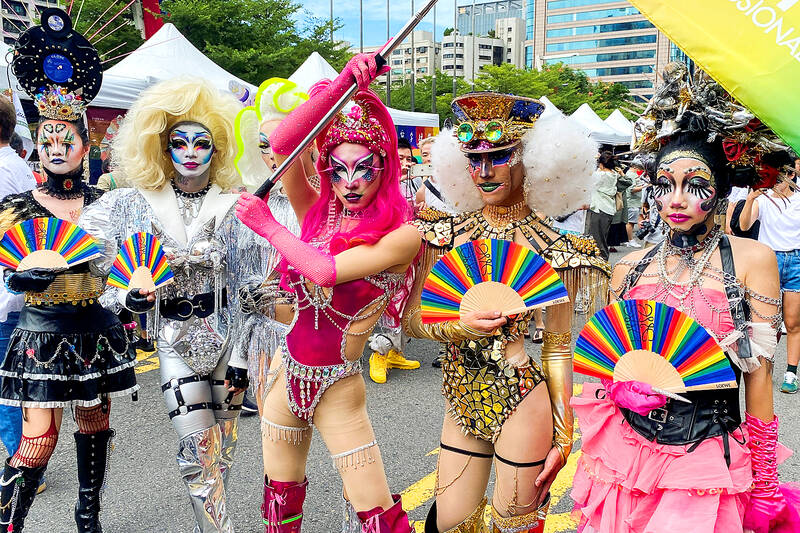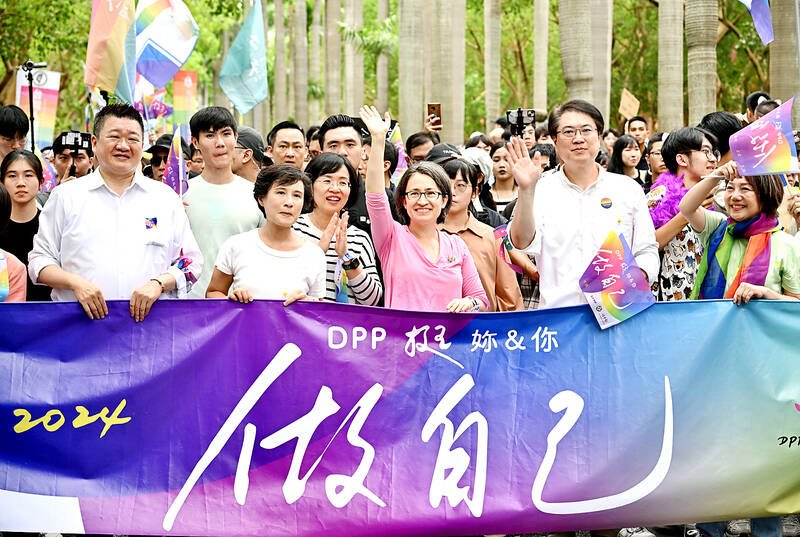More than 180,000 people yesterday celebrated LGBTQ+ equality and diversity in Taipei at East Asia’s largest Pride march, joined by Vice President Hsiao Bi-khim (蕭美琴) and the reigning queen of RuPaul’s Drag Race, Nymphia Wind.
Taiwan legalized same-sex marriage in 2019 in a first for East Asia, a region where the rights of sexual minorities are often either suppressed or outlawed.
The theme of the 22nd iteration of the march was “embracing inclusion,” said Fletcher Hong (小鯨), chairman of the Taiwan Rainbow Civil Action Association, the parade’s organizer.

Photo: Daniel Ceng, EPA-EFE
Inclusion has long been a goal of the LGBTQ+ community and the organizers hope that every person can be included in making national decisions and that people can respect each other’s differences, he said.
Regarding criticism of a ruling that allows Taiwanese to change their gender on their national identification card without reassignment therapy, Hong said the LGBTQ community supports people’s right to not have their identity challenged by others.
The discourse surrounding transgender women using women’s restrooms is about sowing fear and mistrust, not protecting women’s safety, he added.

Photo: Liu Hsin-de, Taipei Times
Association spokesman Simon Tai (戴佑勳) said 194 groups signed up for this year’s parade, with 100 vendors including 30 nonprofit stalls in the “rainbow market” and more than 20 vendors supporting LGBTQ-friendly hotels.
Australian, British, Canadian, New Zealand, Swedish and US representative offices and groups from Malaysia, Hong Kong and Japan joined the event, he said.
Non-governmental organizations invited to speak at the event’s stage included advocacy groups for indigenous people and people with HIV, with the latter calling for attention to inadequate long-term care for aging AIDS patients, he said.

Photo: by Yu Chien-huang, AFP
Nymphia, who won RuPaul’s Drag Race in April, appeared at the parade wearing an outfit inspired by medieval armor with a rainbow flag shoulder cape.
“I just have to come back every year for the parade,” she said, describing her armor look as representing the defense of gay rights.
Hsiao led the Democratic Progressive Party delegation, marching behind a banner reading “Be Yourself.”

Photo: Ben Blanchard, Reuters
She said Taiwanese should be proud of their hard work in making the nation a beacon of progressive values.
President William Lai (賴清德) posted a video message of support on social media, saying he could not march in person this year due to prior appointments and for security reasons.
“The government will continue to work hard to put into practice gender equality so everyone in this land of Taiwan can embrace inclusion and not fear what others think,” he said.

Photo: Liu Hsin-de, Taipei Times
Taiwan People’s Party (TPP) Legislator Vivian Huang (黃珊珊) said political parties should work together to make Taiwan a more harmonious society by supporting the right to have children regardless of sexual orientation or gender identity.
TPP Legislator Chen Gau-tzu (陳昭姿) said that surrogacy legalization would benefit same-sex couples that want to raise a family.
First launched in 2003, the annual Pride parade in Taipei has grown over the years to become one of the largest in Asia.
Event organizers said that the more than 180,000 people who participated in yesterday’s event was more than last year’s 176,000 attendees.

SECURITY: As China is ‘reshaping’ Hong Kong’s population, Taiwan must raise the eligibility threshold for applications from Hong Kongers, Chiu Chui-cheng said When Hong Kong and Macau citizens apply for residency in Taiwan, it would be under a new category that includes a “national security observation period,” Mainland Affairs Council (MAC) Minister Chiu Chui-cheng (邱垂正) said yesterday. President William Lai (賴清德) on March 13 announced 17 strategies to counter China’s aggression toward Taiwan, including incorporating national security considerations into the review process for residency applications from Hong Kong and Macau citizens. The situation in Hong Kong is constantly changing, Chiu said to media yesterday on the sidelines of the Taipei Technology Run hosted by the Taipei Neihu Technology Park Development Association. With

CARROT AND STICK: While unrelenting in its military threats, China attracted nearly 40,000 Taiwanese to over 400 business events last year Nearly 40,000 Taiwanese last year joined industry events in China, such as conferences and trade fairs, supported by the Chinese government, a study showed yesterday, as Beijing ramps up a charm offensive toward Taipei alongside military pressure. China has long taken a carrot-and-stick approach to Taiwan, threatening it with the prospect of military action while reaching out to those it believes are amenable to Beijing’s point of view. Taiwanese security officials are wary of what they see as Beijing’s influence campaigns to sway public opinion after Taipei and Beijing gradually resumed travel links halted by the COVID-19 pandemic, but the scale of

A US Marine Corps regiment equipped with Naval Strike Missiles (NSM) is set to participate in the upcoming Balikatan 25 exercise in the Luzon Strait, marking the system’s first-ever deployment in the Philippines. US and Philippine officials have separately confirmed that the Navy Marine Expeditionary Ship Interdiction System (NMESIS) — the mobile launch platform for the Naval Strike Missile — would take part in the joint exercise. The missiles are being deployed to “a strategic first island chain chokepoint” in the waters between Taiwan proper and the Philippines, US-based Naval News reported. “The Luzon Strait and Bashi Channel represent a critical access

Pope Francis is be laid to rest on Saturday after lying in state for three days in St Peter’s Basilica, where the faithful are expected to flock to pay their respects to history’s first Latin American pontiff. The cardinals met yesterday in the Vatican’s synod hall to chart the next steps before a conclave begins to choose Francis’ successor, as condolences poured in from around the world. According to current norms, the conclave must begin between May 5 and 10. The cardinals set the funeral for Saturday at 10am in St Peter’s Square, to be celebrated by the dean of the College